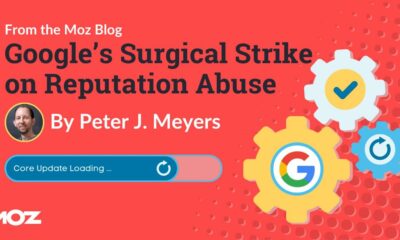SEO
7 Popular White Hat Link Building Techniques (That SEOs Are Still Using Today)

Every year, the SEO agency Aira conducts a State of Link Building survey.
In the most recent edition, 270 SEOs voted for the link-building techniques they still use today.
Let’s look at how to do these seven tactics.
Also known as creating link bait, the goal is to create something so valuable and interesting that other people want to link to it.
How to do it
There’s no surefire way to do this. If it was so easy, everyone would be doing it. That said, there are ways to find link-bait ideas. One way is to piggyback off what’s already working for your competitors.
Here’s how:
- Go to Ahrefs’ Site Explorer
- Enter your competitor’s domain
- Go to the Best by links report


This report shows which of your competitors’ pages attracted the most backlinks. Eyeball the list to see what topics and formats resonate in your industry.
For example, data studies and statistics are popular in the SEO niche:
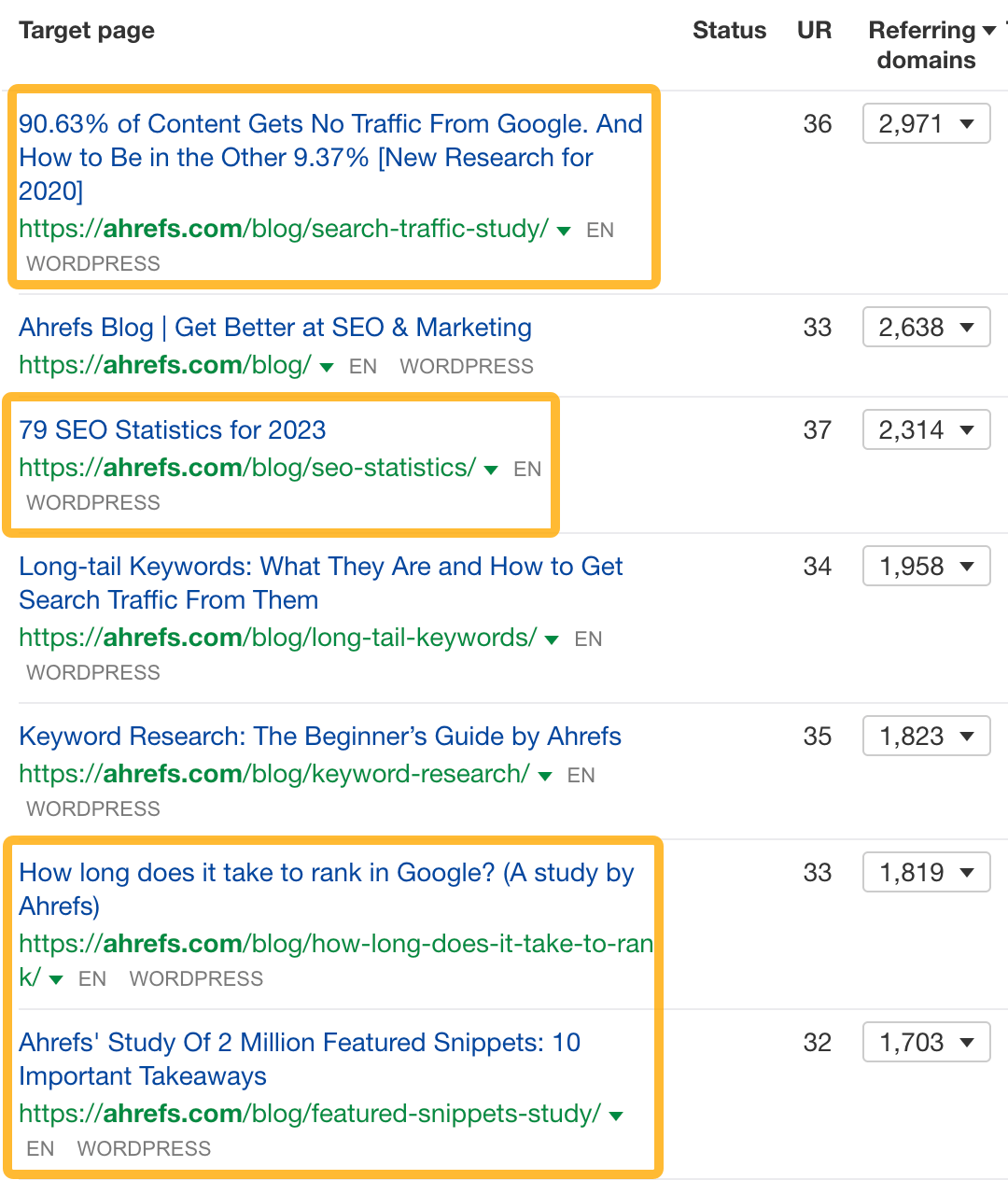

If you’re in this space, you can probably attract links to this kind of content, too.
Just remember that creating content “designed to entice links” doesn’t mean you’ll automatically get them. People won’t magically find your content and link to it. You promote it. Learn how to do that in my content promotion post.
This technique is about looking at how your competitors get links and how you can do the same for your website.
How to do it
First, you’ll need to check the backlink profile of your competitors’ websites.
Here’s how:
- Go to Ahrefs’ Site Explorer
- Enter your competitor’s domain
- Go to the Backlinks report
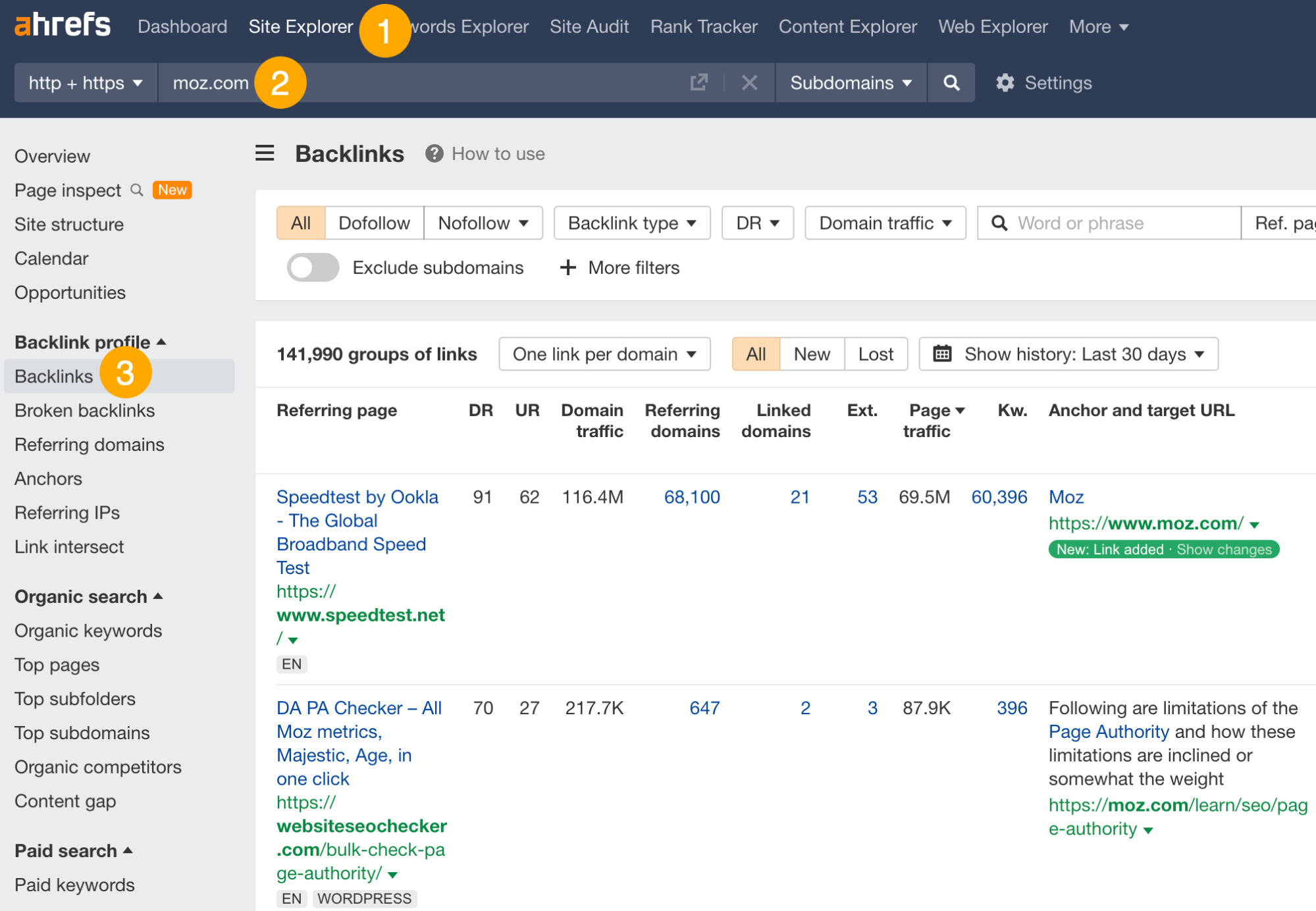

Rather than identifying specific links to replicate, look for patterns. This will help you spot link-building strategies that your competitors are using successfully.
For example, we see that the Moz team has appeared on multiple podcasts:
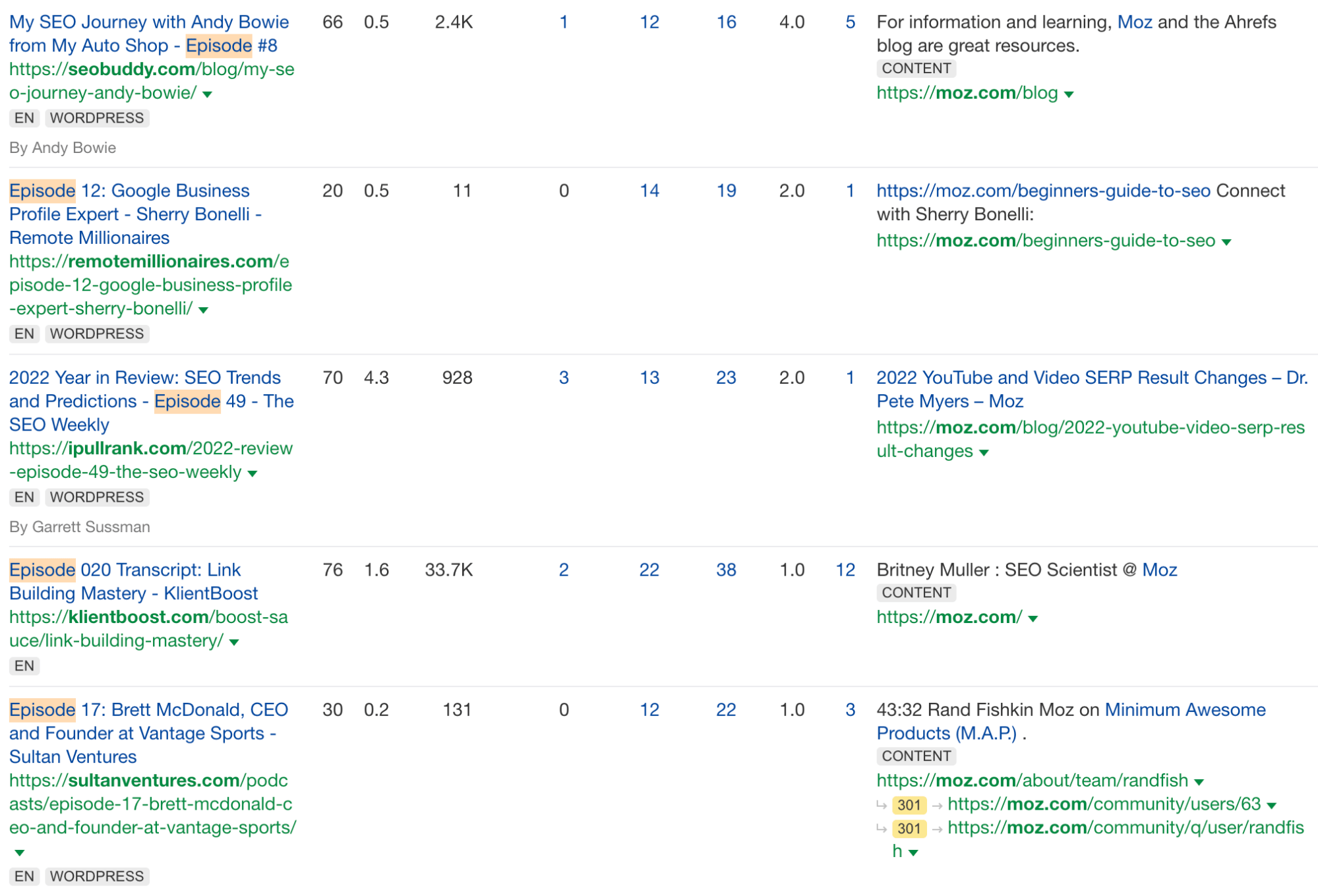

This tells us that podcast link-building is a strategy that works in our industry. We can do the same too. We can curate podcast opportunities by looking for those our competitors have already appeared on, and we can also find more podcast opportunities by following the process in this video:
Guest posting is where you write a post for someone else’s website.
How to do it
The best websites to write for are those that already get lots of traffic to content about similar topics to the one you want to write about. Here’s how to find these websites:
- Open Ahrefs’ Content Explorer
- Enter a related topic and change the dropdown to “In title”
- Filter for English results
- Filter for results with 500+ words
- Go to the “Websites” tab
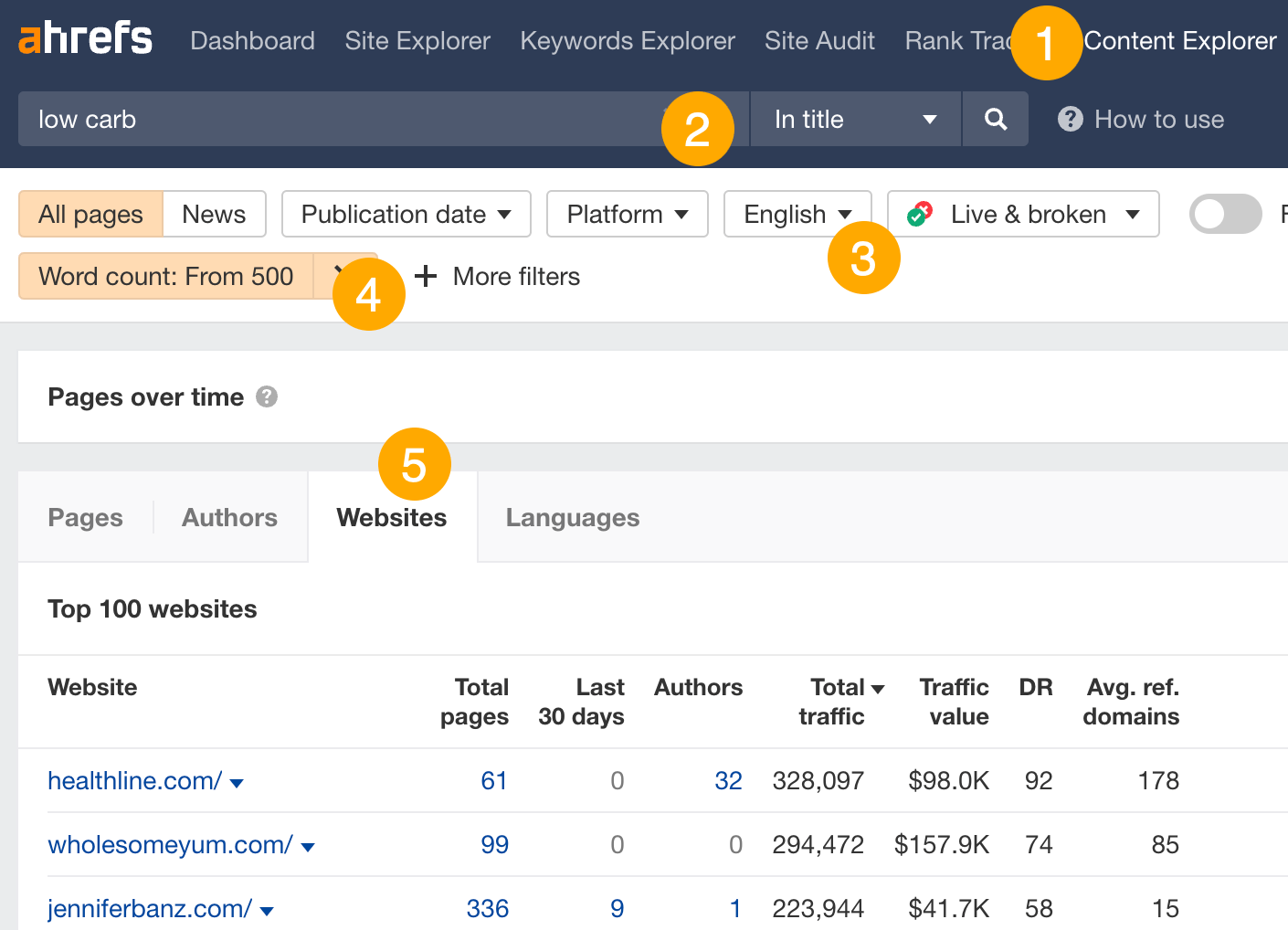

This shows you the websites getting the most organic search traffic to content about your topic.
From here, you want to eyeball the Authors column and prioritize websites with multiple authors, as this often points to them accepting guest posts.
For example, Perfect Keto gets an estimated 19K monthly search visits from 20 authors for the topic “low carb”:


It’s likely that some of these are guest authors, so this could be a good site to pitch.
Reactive PR is where you react quickly to time-sensitive opportunities to earn links.
How to do it
It varies from industry to industry, but it’s common to use Help a Reporter Out (HARO). This platform connects journalists looking for quotes and feedback to expert sources. You can sign up for free and respond to any you can answer.
For example, a journalist at HandicappedPets.com put out a query:


Dr. Jonathan Roberts, a veterinarian at PetKeen.com, responded and earned a link:


After you sign up for HARO, you’ll receive three emails a day.
Given that you should only respond to relevant queries where you have the expertise to answer, I recommend setting up some Gmail filters. This will spare your inbox by filtering out irrelevant opportunities.
Here’s how to do it:
- Click the search options filter
- Set the “From” field to [email protected].
- Set the “Subject” to “[HARO]”
- Set “Has the words” to keywords you want to monitor (you can use the OR operator to list multiple keywords here)


Hit search and check that everything’s correct. If all looks good, hit the search options caret again and click “Create filter.”
Broken link building is where you:
- Find a dead page with links
- Create your own page on the topic
- Ask people linking to the dead page to link to you instead
How to do it
First, you’ll need to find a dead page with links. Here’s how:
- Go to Ahrefs’ Content Explorer
- Search for a topic
- Filter for broken pages only
- Filter for pages with 10+ referring domains


For example, searching for “keto” finds this page with 104 referring domains:


If you visit the page, you’ll see that it is indeed dead:
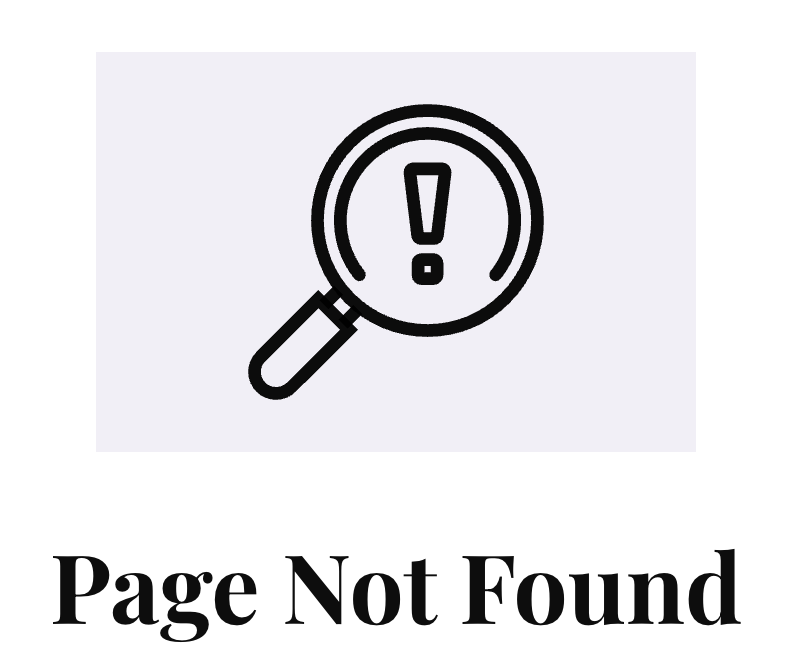

Next, click on the caret next to the URL and click to view it on archive.org. This will show you how the page looked before it disappeared.
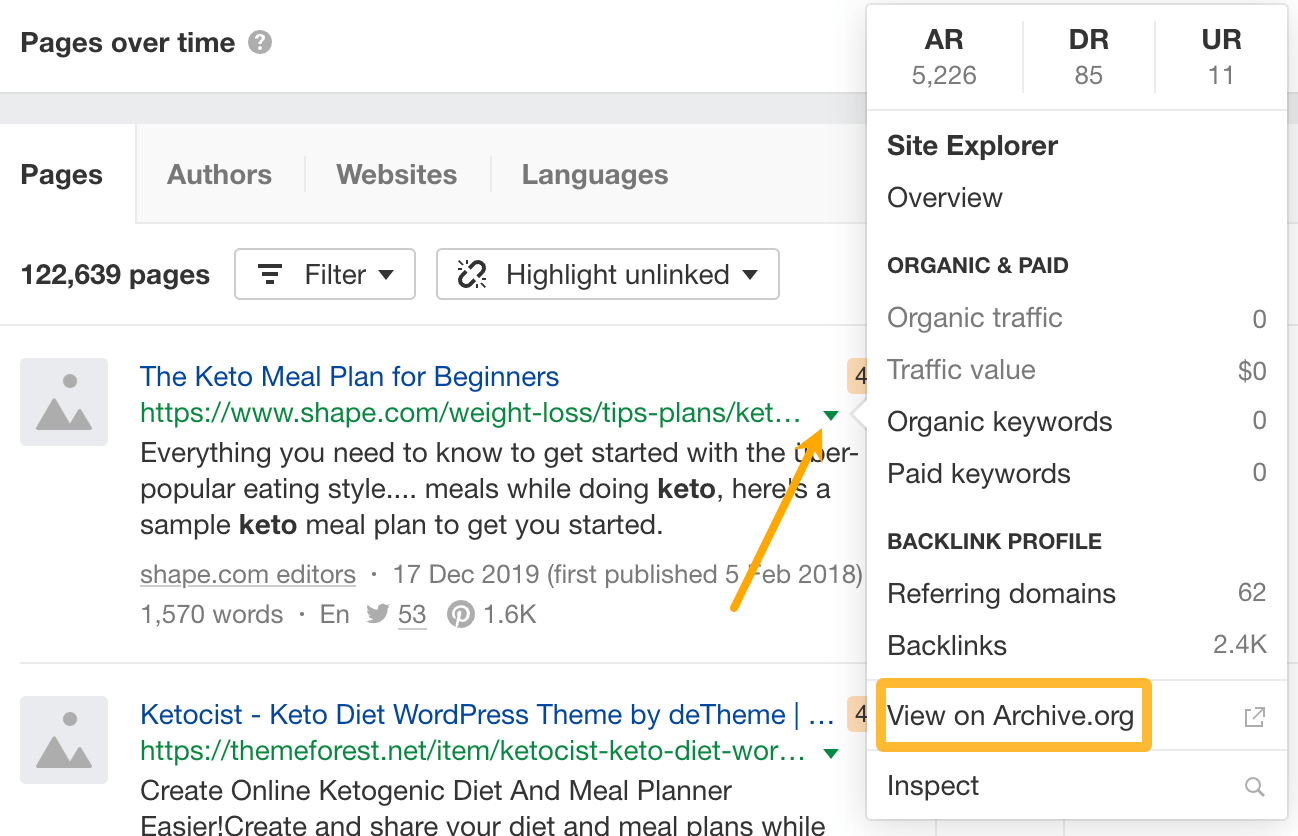

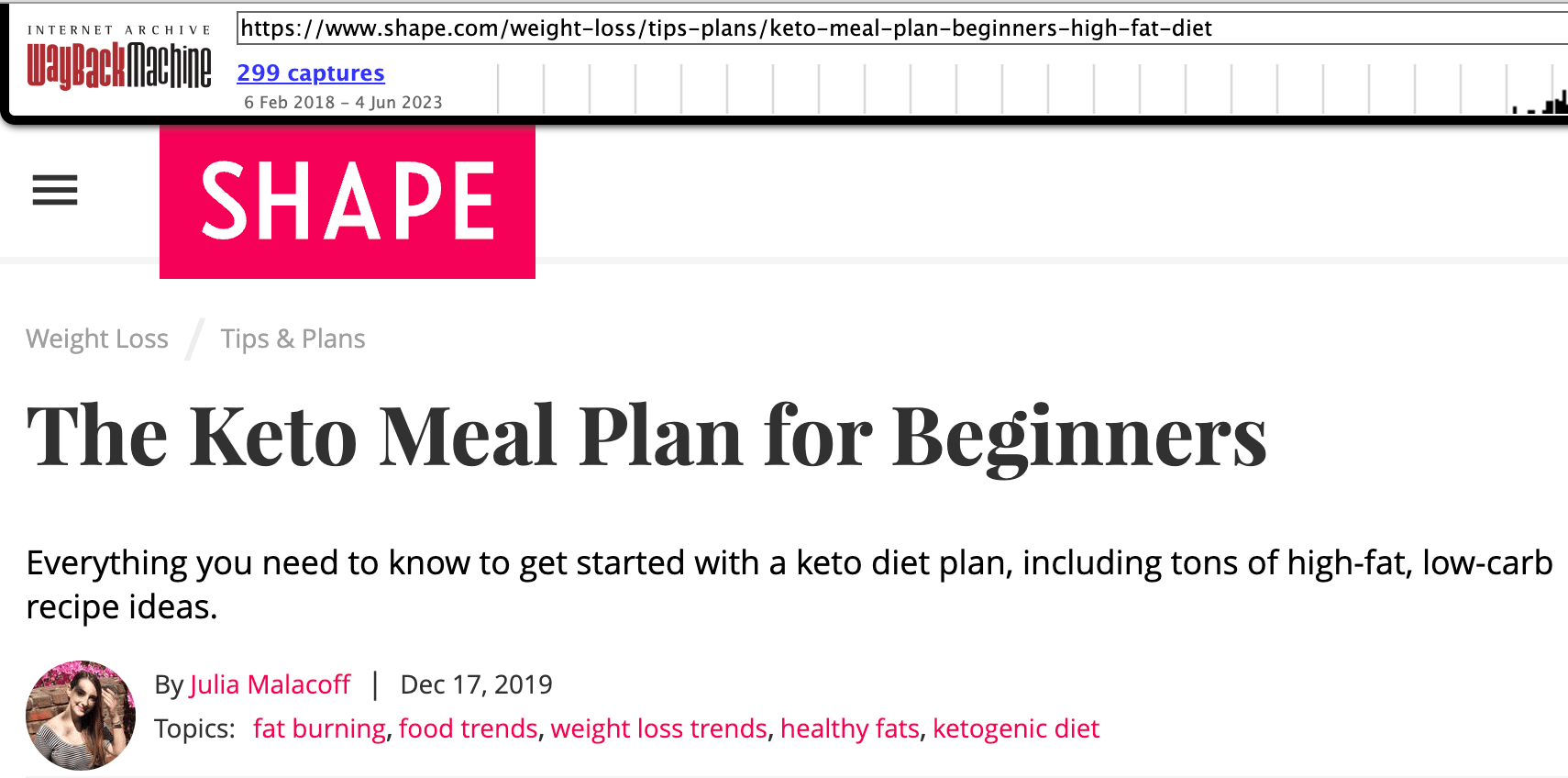

If recreating this content makes sense for your site, do it, then reach out to all the people linking to the dead page and pitch yours as a replacement.
You can find these linkers by entering the dead page’s URL into Site Explorer and going to the Backlinks report.
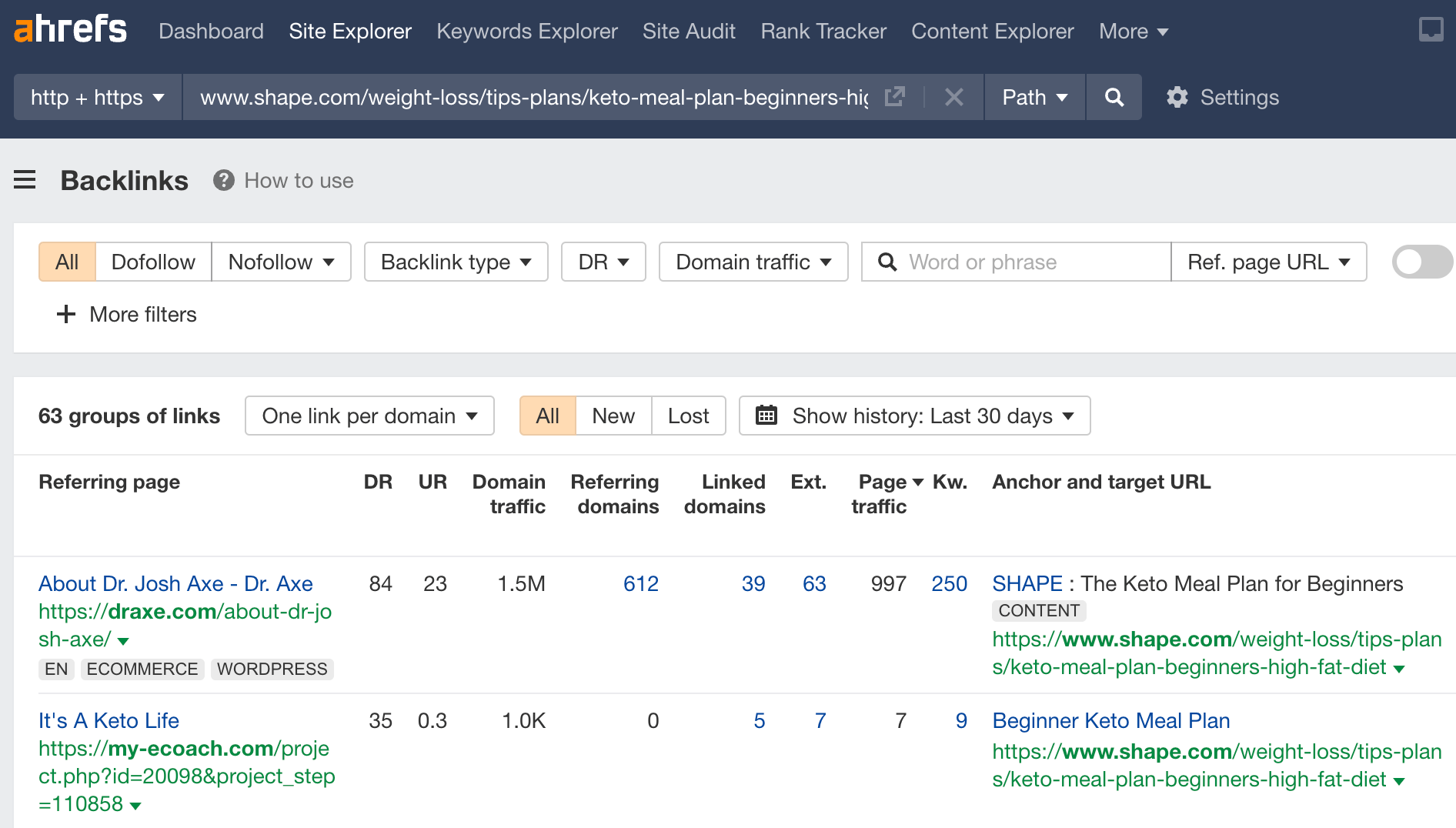

The main focus of this technique is trying to convert unlinked mentions to linked mentions.
How to do it
First, you need to find your unlinked mentions. You can do this by running the following search in Ahrefs’ Web Explorer:
[your brand] -outlinkdomain:[yourwebsite].com -site:[yourwebsite].com -intitle:[your brand]
This will search billions of pages for those that mention your brand name, but don’t link to you.
For example, if you wanted to find unlinked mentions for Ahrefs.com, you’d search for this:


In this case, the search finds over 59 million results:


That’s too many to sift through, so I recommend adding these filters:
- Domain Rating: 30+ to remove low authority websites.
- Language: English to remove those who won’t understand your pitch.
- First seen: 6 months to remove old pages people don’t care about updating.
- One page per domain to remove duplicate websites.
- Filter explicit results to remove results your boss won’t want to see.
- Exclude subdomains to reduce spammy results.


From there, look through the results for unlinked mentions that make sense to pitch.
For example, this page discusses our new search engine:
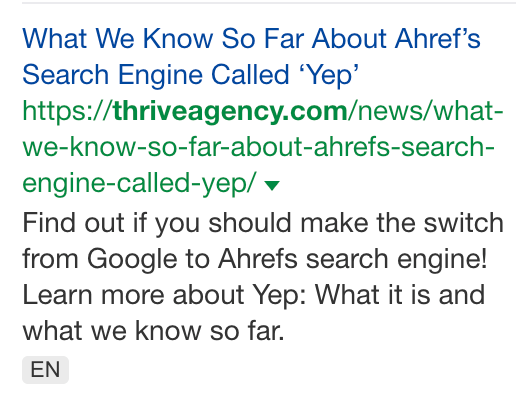

Although the article links to our search engine (Yep.com), it doesn’t link to Ahrefs. That’s especially odd as it mentions “ahrefs” 16 times and talks about us in the intro:


Given that adding a link here would be helpful to readers who aren’t familiar with us, this is an unlinked mention worth chasing.
Looking for another way to earn brand mentions?
Try getting your brand included in listicles.
For example, if you run a cafe in London and you’re not featured in lists of the best cafes in London, that’s an opportunity.
To find relevant listicles, Google this query:
best [business type] in [location] -”[your business name]”
For example, if you’re the owner of Chinese Gourmet in London, you might search for something like this:


If you find listicles that don’t include your restaurant (like the one below), reach out and see if they’d be willing to add you.
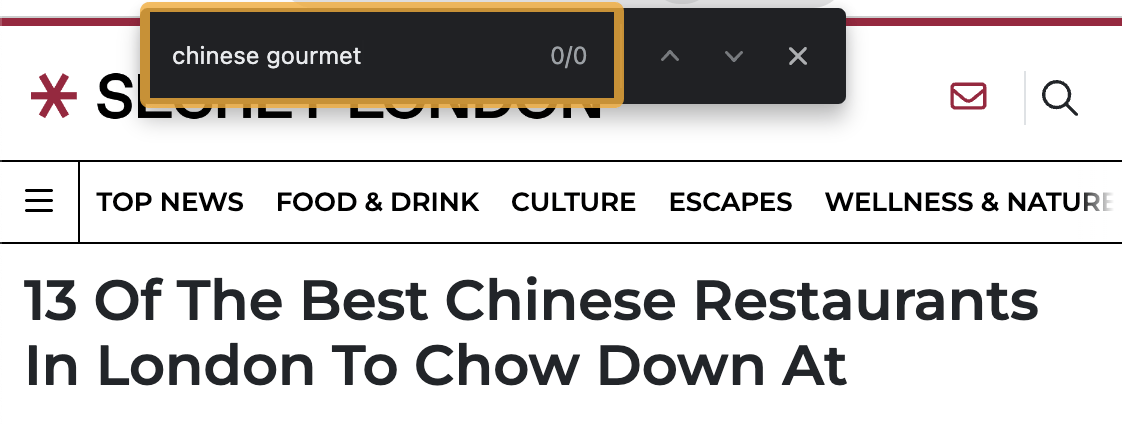

Just keep in mind that your pitch needs to make sense. If the author of the listicle has never eaten at your restaurant, they’re hardly going to add you just because you asked. You’ll have more chance of success by inviting them down for some food and going from there.
This technique could mean various things, so I’ll focus on the “news” part. Essentially, it’s promoting relevant brand information (e.g., your company is going to IPO) and getting publications to cover it.
How to do it
This technique is the remit of my colleague, Daria Samokish. She successfully got TechCrunch to cover our new search engine, Yep.
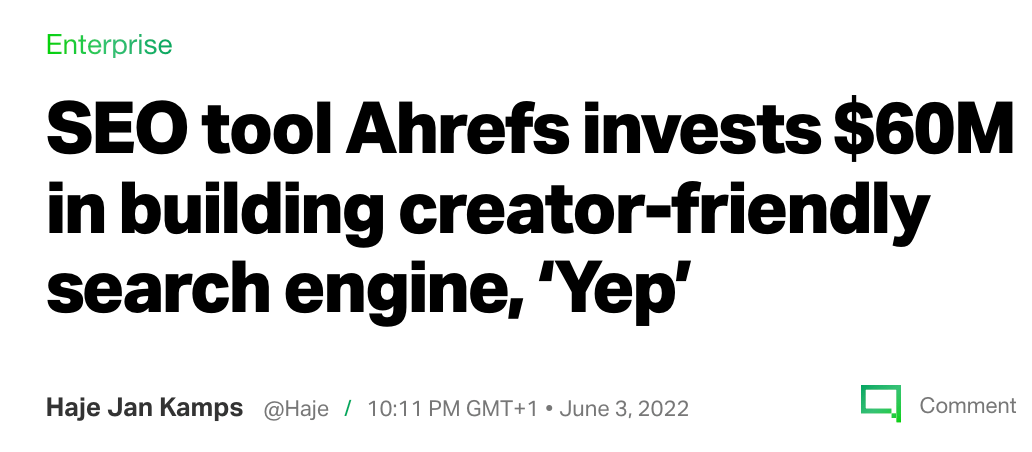

She shared everything she did in this X (Twitter) thread:
Keep learning
If you’re looking for even more link-building techniques that work, check out these resources:
Any questions or comments? Let me know on X (Twitter).
SEO
Google Rolls Out New ‘Web’ Filter For Search Results

Google is introducing a filter that allows you to view only text-based webpages in search results.
The “Web” filter, rolling out globally over the next two days, addresses demand from searchers who prefer a stripped-down, simplified view of search results.
Danny Sullivan, Google’s Search Liaison, states in an announcement:
“We’ve added this after hearing from some that there are times when they’d prefer to just see links to web pages in their search results, such as if they’re looking for longer-form text documents, using a device with limited internet access, or those who just prefer text-based results shown separately from search features.”
We’ve added this after hearing from some that there are times when they’d prefer to just see links to web pages in their search results, such as if they’re looking for longer-form text documents, using a device with limited internet access, or those who just prefer text-based…
— Google SearchLiaison (@searchliaison) May 14, 2024
The new functionality is a throwback to when search results were more straightforward. Now, they often combine rich media like images, videos, and shopping ads alongside the traditional list of web links.
How It Works
On mobile devices, the “Web” filter will be displayed alongside other filter options like “Images” and “News.”
If Google’s systems don’t automatically surface it based on the search query, desktop users may need to select “More” to access it.
 Screenshot from: twitter.com/GoogleSearchLiaison, May 2024.
Screenshot from: twitter.com/GoogleSearchLiaison, May 2024.More About Google Search Filters
Google’s search filters allow you to narrow results by type. The options displayed are dynamically generated based on your search query and what Google’s systems determine could be most relevant.
The “All Filters” option provides access to filters that are not shown automatically.
Alongside filters, Google also displays “Topics” – suggested related terms that can further refine or expand a user’s original query into new areas of exploration.
For more about Google’s search filters, see its official help page.
Featured Image: egaranugrah/Shutterstock
SEO
Why Google Can’t Tell You About Every Ranking Drop

In a recent Twitter exchange, Google’s Search Liaison, Danny Sullivan, provided insight into how the search engine handles algorithmic spam actions and ranking drops.
The discussion was sparked by a website owner’s complaint about a significant traffic loss and the inability to request a manual review.
Sullivan clarified that a site could be affected by an algorithmic spam action or simply not ranking well due to other factors.
He emphasized that many sites experiencing ranking drops mistakenly attribute it to an algorithmic spam action when that may not be the case.
“I’ve looked at many sites where people have complained about losing rankings and decide they have a algorithmic spam action against them, but they don’t. “
Sullivan’s full statement will help you understand Google’s transparency challenges.
Additionally, he explains why the desire for manual review to override automated rankings may be misguided.
Two different things. A site could have an algorithmic spam action. A site could be not ranking well because other systems that *are not about spam* just don’t see it as helpful.
I’ve looked at many sites where people have complained about losing rankings and decide they have a…
— Google SearchLiaison (@searchliaison) May 13, 2024
Challenges In Transparency & Manual Intervention
Sullivan acknowledged the idea of providing more transparency in Search Console, potentially notifying site owners of algorithmic actions similar to manual actions.
However, he highlighted two key challenges:
- Revealing algorithmic spam indicators could allow bad actors to game the system.
- Algorithmic actions are not site-specific and cannot be manually lifted.
Sullivan expressed sympathy for the frustration of not knowing the cause of a traffic drop and the inability to communicate with someone about it.
However, he cautioned against the desire for a manual intervention to override the automated systems’ rankings.
Sullivan states:
“…you don’t really want to think “Oh, I just wish I had a manual action, that would be so much easier.” You really don’t want your individual site coming the attention of our spam analysts. First, it’s not like manual actions are somehow instantly processed. Second, it’s just something we know about a site going forward, especially if it says it has change but hasn’t really.”
Determining Content Helpfulness & Reliability
Moving beyond spam, Sullivan discussed various systems that assess the helpfulness, usefulness, and reliability of individual content and sites.
He acknowledged that these systems are imperfect and some high-quality sites may not be recognized as well as they should be.
“Some of them ranking really well. But they’ve moved down a bit in small positions enough that the traffic drop is notable. They assume they have fundamental issues but don’t, really — which is why we added a whole section about this to our debugging traffic drops page.”
Sullivan revealed ongoing discussions about providing more indicators in Search Console to help creators understand their content’s performance.
“Another thing I’ve been discussing, and I’m not alone in this, is could we do more in Search Console to show some of these indicators. This is all challenging similar to all the stuff I said about spam, about how not wanting to let the systems get gamed, and also how there’s then no button we would push that’s like “actually more useful than our automated systems think — rank it better!” But maybe there’s a way we can find to share more, in a way that helps everyone and coupled with better guidance, would help creators.”
Advocacy For Small Publishers & Positive Progress
In response to a suggestion from Brandon Saltalamacchia, founder of RetroDodo, about manually reviewing “good” sites and providing guidance, Sullivan shared his thoughts on potential solutions.
He mentioned exploring ideas such as self-declaration through structured data for small publishers and learning from that information to make positive changes.
“I have some thoughts I’ve been exploring and proposing on what we might do with small publishers and self-declaring with structured data and how we might learn from that and use that in various ways. Which is getting way ahead of myself and the usual no promises but yes, I think and hope for ways to move ahead more positively.”
Sullivan said he can’t make promises or implement changes overnight, but he expressed hope for finding ways to move forward positively.
Featured Image: Tero Vesalainen/Shutterstock
SEO
56 Google Search Statistics to Bookmark for 2024

If you’re curious about the state of Google search in 2024, look no further.
Each year we pick, vet, and categorize a list of up-to-date statistics to give you insights from trusted sources on Google search trends.
- Google has a web index of “about 400 billion documents”. (The Capitol Forum)
- Google’s search index is over 100 million gigabytes in size. (Google)
- There are an estimated 3.5 billion searches on Google each day. (Internet Live Stats)
- 61.5% of desktop searches and 34.4% of mobile searches result in no clicks. (SparkToro)
- 15% of all Google searches have never been searched before. (Google)
- 94.74% of keywords get 10 monthly searches or fewer. (Ahrefs)
- The most searched keyword in the US and globally is “YouTube,” and youtube.com gets the most traffic from Google. (Ahrefs)
- 96.55% of all pages get zero search traffic from Google. (Ahrefs)
- 50-65% of all number-one spots are dominated by featured snippets. (Authority Hacker)
- Reddit is the most popular domain for product review queries. (Detailed)
- Google is the most used search engine in the world, with a mobile market share of 95.32% and a desktop market share of 81.95%. (Statista)


- Google.com generated 84.2 billion visits a month in 2023. (Statista)
- Google generated $307.4 billion in revenue in 2023. (Alphabet Investor Relations)
- 63.41% of all US web traffic referrals come from Google. (SparkToro)
- 92.96% of global traffic comes from Google Search, Google Images, and Google Maps. (SparkToro)
- Only 49% of Gen Z women use Google as their search engine. The rest use TikTok. (Search Engine Land)
- 58.67% of all website traffic worldwide comes from mobile phones. (Statista)
- 57% of local search queries are submitted using a mobile device or tablet. (ReviewTrackers)


- 51% of smartphone users have discovered a new company or product when conducting a search on their smartphones. (Think With Google)
- 54% of smartphone users search for business hours, and 53% search for directions to local stores. (Think With Google)
- 18% of local searches on smartphones lead to a purchase within a day vs. 7% of non-local searches. (Think With Google)
- 56% of in-store shoppers used their smartphones to shop or research items while they were in-store. (Think With Google)
- 60% of smartphone users have contacted a business directly using the search results (e.g., “click to call” option). (Think With Google)
- 63.6% of consumers say they are likely to check reviews on Google before visiting a business location. (ReviewTrackers)
- 88% of consumers would use a business that replies to all of its reviews. (BrightLocal)
- Customers are 2.7 times more likely to consider a business reputable if they find a complete Business Profile on Google Search and Maps. (Google)
- Customers are 70% more likely to visit and 50% more likely to consider purchasing from businesses with a complete Business Profile. (Google)
- 76% of people who search on their smartphones for something nearby visit a business within a day. (Think With Google)
- 28% of searches for something nearby result in a purchase. (Think With Google)
- Mobile searches for “store open near me” (such as, “grocery store open near me” have grown by over 250% in the last two years. (Think With Google)
- People use Google Lens for 12 billion visual searches a month. (Google)
- 50% of online shoppers say images helped them decide what to buy. (Think With Google)
- There are an estimated 136 billion indexed images on Google Image Search. (Photutorial)
- 15.8% of Google SERPs show images. (Moz)
- People click on 3D images almost 50% more than static ones. (Google)
- More than 800 million people use Google Discover monthly to stay updated on their interests. (Google)
- 46% of Google Discover URLs are news sites, 44% e-commerce, 7% entertainment, and 2% travel. (Search Engine Journal)
- Even though news sites accounted for under 50% of Google Discover URLs, they received 99% of Discover clicks. (Search Engine Journal)


- Most Google Discover URLs only receive traffic for three to four days, with most of that traffic occurring one to two days after publishing. (Search Engine Journal)
- The clickthrough rate (CTR) for Google Discover is 11%. (Search Engine Journal)
- 91.45% of search volumes in Google Ads Keyword Planner are overestimates. (Ahrefs)
- For every $1 a business spends on Google Ads, they receive $8 in profit through Google Search and Ads. (Google)
- Google removed 5.5 billion ads, suspended 12.7 million advertiser accounts, restricted over 6.9 billion ads, and restricted ads from showing up on 2.1 billion publisher pages in 2023. (Google)
- The average shopping click-through rate (CTR) across all industries is 0.86% for Google Ads. (Wordstream)
- The average shopping cost per click (CPC) across all industries is $0.66 for Google Ads. (Wordstream)
- The average shopping conversion rate (CVR) across all industries is 1.91% for Google Ads. (Wordstream)
- 58% of consumers ages 25-34 use voice search daily. (UpCity)
- 16% of people use voice search for local “near me” searches. (UpCity)
- 67% of consumers say they’re very likely to use voice search when seeking information. (UpCity)
- Active users of the Google Assistant grew 4X over the past year, as of 2019. (Think With Google)
- Google Assistant hit 1 billion app installs. (Android Police)
- AI-generated answers from SGE were available for 91% of entertainment queries but only 17% of healthcare queries. (Statista)
- The AI-generated answers in Google’s Search Generative Experience (SGE) do not match any links from the top 10 Google organic search results 93.8% of the time. (Search Engine Journal)
- Google displays a Search Generative element for 86.8% of all search queries. (Authoritas)


- 62% of generative links came from sources outside the top 10 ranking organic domains. Only 20.1% of generative URLs directly match an organic URL ranking on page one. (Authoritas)
- 70% of SEOs said that they were worried about the impact of SGE on organic search (Aira)
Learn more
Check out more resources on how Google works:
-

 PPC7 days ago
PPC7 days agoHow the TikTok Algorithm Works in 2024 (+9 Ways to Go Viral)
-

 SEO6 days ago
SEO6 days agoHow to Use Keywords for SEO: The Complete Beginner’s Guide
-

 MARKETING7 days ago
MARKETING7 days agoHow To Protect Your People and Brand
-

 MARKETING4 days ago
MARKETING4 days agoAdvertising on Hulu: Ad Formats, Examples & Tips
-

 MARKETING5 days ago
MARKETING5 days agoUpdates to data build service for better developer experiences
-

 SEO7 days ago
SEO7 days agoAutomate Multi-Site Reporting With Google Sheets And GSC API
-

 MARKETING1 day ago
MARKETING1 day ago18 Events and Conferences for Black Entrepreneurs in 2024
-

 MARKETING6 days ago
MARKETING6 days agoThe Ultimate Guide to Email Marketing


